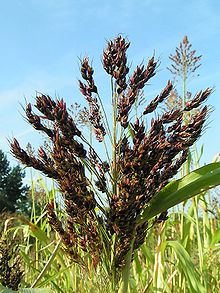Our website is made possible by displaying online advertisements to our visitors.
Please consider supporting us by disabling your ad blocker.
Sorghum bicolor
| Sorghum bicolor | |
|---|---|

| |
| Scientific classification | |
| Kingdom: | Plantae |
| Clade: | Tracheophytes |
| Clade: | Angiosperms |
| Clade: | Monocots |
| Clade: | Commelinids |
| Order: | Poales |
| Family: | Poaceae |
| Subfamily: | Panicoideae |
| Genus: | Sorghum |
| Species: | S. bicolor
|
| Binomial name | |
| Sorghum bicolor | |
| Synonyms[1] | |
|
List
| |

Sorghum bicolor, commonly called sorghum[2] (/ˈsɔːrɡəm/) and also known as great millet, durra, jowari / jowar, or milo, is a grass species cultivated for its grain, which is used for food for humans, animal feed, and ethanol production. Sorghum originated in Africa, and is now cultivated widely in tropical and subtropical regions.[3] Sorghum is the world's fifth-most important cereal crop after rice, wheat, maize, and barley, with 59.34 million metric tons of annual global production in 2018.[4] S. bicolor is typically an annual, but some cultivars are perennial. It grows in clumps that may reach over 4 m high. The grain is small, ranging from 2 to 4 mm in diameter. Sweet sorghums are sorghum cultivars that are primarily grown for forage, syrup production, and ethanol; they are taller than those grown for grain.[5][6]
Sorghum bicolor is the cultivated species of sorghum; its wild relatives make up the botanical genus Sorghum.
- ↑ "Sorghum bicolor (L.) Moench — The Plant List". www.theplantlist.org. Archived from the original on 2023-04-13. Retrieved 2021-12-10.
- ↑ "Sorghum bicolor". Natural Resources Conservation Service PLANTS Database. USDA. Retrieved 2 February 2016.
- ↑ Dillon, Sally L.; Shapter, Frances M.; Henry, Robert J.; et al. (1 September 2007). "Domestication to Crop Improvement: Genetic Resources for Sorghum and Saccharum (Andropogoneae)". Annals of Botany. 100 (5): 975–989. doi:10.1093/aob/mcm192. PMC 2759214. PMID 17766842.
- ↑ "FAOSTAT". www.fao.org. Retrieved 2020-09-27.
- ↑ "Grassland Index: Sorghum bicolor (L.) Moench". Archived from the original on 2017-11-19. Retrieved 2021-12-10.
- ↑ "Sweet Sorghum". Sweet Sorghum Ethanol Producers. Archived from the original on 28 October 2016. Retrieved 13 November 2012.
Previous Page Next Page


